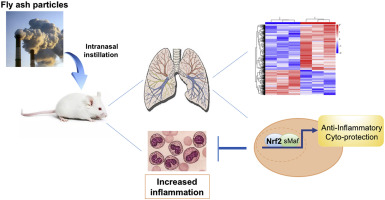当前位置:
X-MOL 学术
›
Ecotox. Environ. Saf.
›
论文详情
Our official English website, www.x-mol.net, welcomes your feedback! (Note: you will need to create a separate account there.)
Transcriptomic profiling identifies a critical role of Nrf2 in regulating the inflammatory response to fly ash particles in mouse lung.
Ecotoxicology and Environmental Safety ( IF 6.8 ) Pub Date : 2020-01-06 , DOI: 10.1016/j.ecoenv.2019.110132 Jingwen Zhang 1 , Huiling Cui 1 , Akhileshwar Namani 2 , Jun Yao 1 , Hong Deng 3 , Xiuwen Tang 4 , Xiu Jun Wang 1
Ecotoxicology and Environmental Safety ( IF 6.8 ) Pub Date : 2020-01-06 , DOI: 10.1016/j.ecoenv.2019.110132 Jingwen Zhang 1 , Huiling Cui 1 , Akhileshwar Namani 2 , Jun Yao 1 , Hong Deng 3 , Xiuwen Tang 4 , Xiu Jun Wang 1
Affiliation

|
Exposure to combustion-derived nanoparticles is recognized as a major health hazard, but the molecular responses are still insufficiently described. The transcription factor erythroid 2-related factor 2 (Nrf2, also known as NFE2L2) is a master regulator of the pulmonary defense system against insults by particulate matter. However, its downstream molecular processes are not fully characterized. In the current study, BALB/c wild-type (WT) and Nrf2-/- mice were exposed by intranasal administration to fly ash particles (F3-S; 20 mg/kg BW), which were collected from a municipal waste incinerator in China, for three consecutive days. Using a comparative transcriptomics approach, the pulmonary global gene expression profiles to F3-S exposure were characterized for both genotypes. The preponderance of the differentially-expressed genes (DEGs) in WT mice induced by the fly ash particles, was related to inflammation. Functional enrichment and molecular pathway mapping of the DEGs specific to Nrf2-/- mice exposed to the particles revealed that all of the top 10 perturbed molecular pathways were associated with the inflammatory response. Our study identified a transcriptional signature related to the initial pulmonary injury in mouse upon fly ash exposure, and suggests an anti-inflammatory role of Nrf2 in protecting the lung against such exposure.
更新日期:2020-01-07



























 京公网安备 11010802027423号
京公网安备 11010802027423号